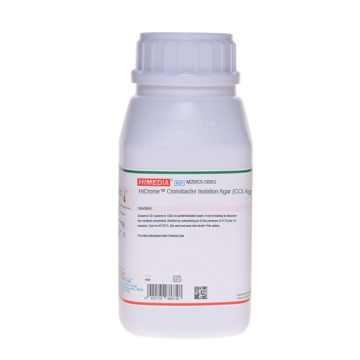 Your enquiry has been submitted
Your enquiry has been submitted
L-Arginine Dihydrolase Medium, Modified
Intended use
L-Arginine dihydrolase medium, modified is recommended as one of the medium for confirmation of Enterobacter sakazakii from milk and milk products.
Composition**
| Ingredients | Gms / Litre |
|---|---|
| L-Arginine, monohydrochloride | 5.000 |
| Yeast extract | 3.000 |
| Glucose | 1.000 |
| Bromocresol purple | 0.015 |
Final pH ( at 25°C) 6.8±0.2
**Formula adjusted, standardized to suit performance parameters
Directions
Dissolve 9.01 grams in 1000 ml distilled water. Heat if necessary to dissolve the medium completely and distribute in 13 x 100mm tubes. Sterilize by autoclaving at 15 lbs pressure (121°C) for 15 minutes. Allow the tubes to cool in an upright position.
Principle And Interpretation
Decarboxylase Media used for the detection of arginine dihydrolase and lysine and ornithine decarboxylase was first introduced by Moeller (1-3). L-Arginine Dihydrolase Medium, Modified is one of the medium recommended for the confirmation of Enterobacter sakazakii from milk and milk products, in accordance with ISO specifications (4). Bacteria can be differentiation on the basis of their decarboxylating activity towards the amino acid. Bacteria producing arginine dihydrolase enzyme in this medium decarboxylates arginine to putrescine . The production of amine, putrescine elevates the pH of medium which is detected by the indicator, bromocresol purple which forms purple in alkaline condition. Colour change from purple to yellow and then back to purple is positive reaction.
Yeast extract provide the necessary nutrients to the organisms while L-arginine stimulates the arginine dihydrolase synthesis and glucose provides the energy source.
As per the ISO specifications (4) the sample under test is enriched in Buffered Peptone Water (M614S). This enriched medium is used for inoculation of Modified Lauryl Sulphate Tryptone Broth Base (M1643). After incubation at 44°C for 24 hours, a loopful is streaked onto HiCrome Enterobacter Sakazakii Agar, Modified (M1641). The presumptive blue-green coloured colonies obtained after incubation are confirmed by performing the biochemical tests. L-Arginine Dihydrolase Medium, Modified (M1644) is one of the biochemical medium used. Arginine reaction is strictly anaerobic; therefore the broth tubes must be overlayed with mineral oil. In differentiation of Enterobacteriaceae, control tubes without arginine must be used. If the tubes give purple reaction the test is considered as negative.
Type of specimen
Food and dairy samples
Specimen Collection and Handling
For food and dairy samples, follow appropriate techniques for sample collection and processing as per guidelines (5). After use, contaminated materials must be sterilized by autoclaving before discarding.
Warning and Precautions
Read the label before opening the container. Wear protective gloves/protective clothing/eye protection/ face protection. Follow good microbiological lab practices while handling specimens and culture. Standard precautions as per established guidleines should be followed while handling specimens. Saftey guidelines may be referred in individual safety data sheets
Limitations
This medium is suited for Arginine hydrolysis of Cronobacter sakazakii. It may not be suited for the detection of arginine hydrolysis of other species.
Performance and Evaluation
Performance of the medium is expected when used as per the direction on the label within the expiry period when stored at recommended temperature.
Quality Control
Appearance Light yellow to grey homogeneous free flowing powder
Colour and Clarity of prepared medium Purple coloured clear solution in tubes
Reaction Reaction of 0.9% w/v aqueous solution at 25°C. pH : 6.8±0.2
pH 6.60-7.00
Cultural Response M1644: Cultural characteristics observed after an incubation at 35-37°C for 18-24 hours.
| Organism | Inoculum (CFU) | Growth | Arginine dihydrolase |
|---|---|---|---|
| Enterobacter aerogenes ATCC 13048 (00175#) | 50-100 | good-luxuriant | negative reaction, yellow colour |
| Klebsiella pneumoniae ATCC 13883 | 50-100 | good-luxuriant | negative reaction, yellow colour |
| *Cronobacter sakazakii ATCC 12868 | 50-100 | good-luxuriant | positive reaction, purple colour |
Key :* - Formerly known as Enterobacter sakazakii, # corresponding WDCM
Storage and Shelf Life
Store between 10-30°C in a tightly closed container and the prepared medium at 2-8°C. Use before expiry date on the label. On opening, product should be properly stored dry, after tightly capping the bottle inorder to prevent lump formation due to the hygroscopic nature of the product. Improper storage of the product may lead to lump formation. Store in dry ventilated area protected from extremes of temperature and sources of ignition Seal the container tightly after use. Use before expiry date on the label.
Product performance is best if used within stated expiry period.
Disposal
User must ensure safe disposal by autoclaving and/or incineration of used or unusable preparations of this product. Follow established laboratory procedures in disposing of infectious materials and material that comes into contact with clinical sample must be decontaminated and disposed of in accordance with current laboratory techniques (6,7).
Reference
- Moeller, 1954, Acta Pathol. Microbiol. Scand., 34:102.
- Moeller, 1954, Acta Pathol. Microbiol. Scand., 34:259.
- Moeller, 1955, Acta Pathol. Microbiol. Scand., 36:158.
- International Organization for Standardization Draft ISO/TS 22964: 2006 (E).
- American Public Health Association, Standard Methods for the Examination of Dairy Products, 1978, 14th Ed., Washington D.C.
- Isenberg, H.D. Clinical Microbiology Procedures Handb0ook. 2nd Edition.
- Jorgensen,J.H., Pfaller , M.A., Carroll, K.C., Funke, G., Landry, M.L., Richter, S.S and Warnock., D.W. (2015) Manual of Clinical Microbiology, 11th Edition. Vol. 1.
| Product Name | L-Arginine Dihydrolase Medium, Modified |
|---|---|
| SKU | M1644 |
| Product Type | Regular |
| Physical Form | Powder |
| Origin | Animal Free (Microbial) |
| Packaging type | HDPE |
| References | 1. Moeller, 1954, Acta Pathol. Microbiol. Scand., 34:102. |
| Customized Product Available | No |







